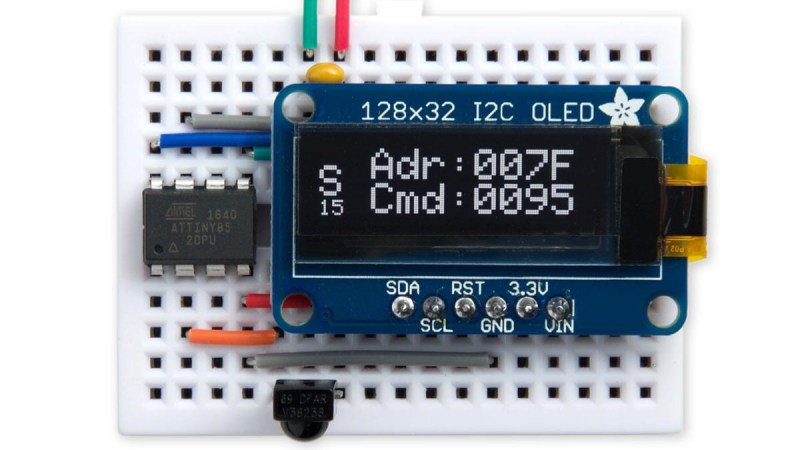Hardware development often involves working with things that can’t be directly perceived, which is one reason good development tools are so important. In appreciation of this, [David Johnson-Davies] created the IR Remote Control Detective to simplify working with IR signals. While IR remote controls are commonplace, there are a number of different protocols and encoding methods in use across different brands. The IR Detective takes care of all of that with three main components, none of which are particularly expensive. To use the decoder, one simply points an IR remote at the unit and presses one of the buttons. The IR Detective will identify the protocol, decode the signal, and display the address and command related to the key that was pressed. The unit doesn’t consist of much more than an ATtiny85 microcontroller, a small OLED display, and an IR receiver unit. The IR receiver used is intended for a 38 kHz carrier, but such receivers can and do respond to signals outside this frequency, although they do so at a reduced range.
As a result, not only is the unit useful for decoding IR or verifying that correct signals are being generated, but the small size and low cost means it could easily be used as a general purpose receiver to add IR remote control to other devices. It’s also halfway to bridging IR to something else, like this WiFi-IR bridge which not only interfaces to legacy hardware, but does it across WiFi to boot.















IR see what you did there…
“Hardware development often involves working with things that can’t be directly perceived, which is one reason good development tools are so important.”
Ever notice magic in fiction never has any debugging tools?
What about Unseen University’s Hex?
https://en.wikipedia.org/wiki/Rick_Cook#Wizardry_series
Really good series from a programmer’s perspective.
One of the storylines in the second book is about debugging tools being mis-used.
Thanks for reminding me. Read ages ago, but couldn’t remember the title.
This is really nothing new or special, except the addition on an LCD,and doing it without a Computer, must have been a slow day in news- previous (ancient examples of this) LIRC, WinLIRC , Bus Pirate to name but a few.
Don’t forget there are newbies jerks and your references to other similar systems. I thought this article seemed neat and interesting… plus is a stand alone more compact system. Also, I learned there is GOODFET42 that I need to read about more since I don’t see Bus Pirate on the store.hackaday.com site anymore though I do see the price has dipped down to under $30 which is less since the last time I looked at buying.
Your first sentence makes no grammatical or logical sense.
Correct Europe. I was replying to your thought comment. “Don’t forget there are newbies jerks”, for instance, references one instance where the NSA agent has recommended I apply or complain to certain FBI divisions regarding gang stalking using silent sound V2K, identity theft, hacking into anything that resonates around me and not just computer systems… including the walls. I have no idea how to describe the not so new found science that I haven’t used or really even read about in 25 plus years. They’re new to the issues and I’m like a jerk who doesn’t describe in detail well enough.
“Your references to other similar systems” is more related to the article and somewhat your thought comment adding references to other similar systems.
Add an IR LED and you could make a remote babelfish.
Any remote could be used as a universal remote. Perhaps adding macros to control other devices when a sequence of events on a primary device were executed. Fading the lighting when the DVD is started. Automatically switching on a sound system to aux in when a music channel is selected.
Man, that would be smooth for dates.
At first I was wondering with a switching circuit just above the relaxation timing of the IR LED… that the IR LED may be able to be used as a detector and emitter. Not sure sensitivity though and complexity to make equally sensitive to a detector.
The most basic IR detector is a cell handset camera that displays the signal and modulation.
Isn’t that limited to the cell phone camera frames per second or am I missing something that can be performed at a really low resolution hacked or consumer setting? A, IR detector could be made with a microphone input and application though that would be ~38kHz.
Seems like an area of opportunity seeing that there are IR Blasters like IRdude, though not much for detectors on the cell phones: https://en.m.wikipedia.org/wiki/List_of_devices_with_IR_blaster